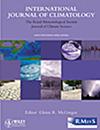CMIP6情景下LARS-WG模式对中国东部地区温度和降水的预估
摘要
不断上升的大气温度和降水模式的变化对农业生产力和水资源管理构成重大威胁。本研究旨在检测中国东部主要作物产区,特别是被认为是中国气候最脆弱地区的安徽、河南东部、山东西南部和江苏北部的农业生产和水文循环中时空特异性决定性气候变量的趋势和未来预测。利用最新版本的朗阿什顿研究站天气发生器(LARS-WG 8)模式,利用6个全球环流模式(ACCESS-ESM1-5、HadGEM3-GC31-LL、MRI-ESM2-0、CNRM-CM6-1、GFDL-ESM4和MPI-ESM1-2-LR),在3条共享社会经济路径(ssp126、ssp245和ssp585)下,预估了2050年中期(2041-2060)和2080年长期(2071-2090)两个未来时期的降水量(P)、最高(Tmax)和最低(Tmin)温度。此外,利用常规趋势分析技术(Mann-Kendall和Sen's Slope检验)结合创新的多边形趋势分析(IPTA),确定了月和年降水趋势的基线(1991-2020)算术平均值和标准差。结果表明:3月份,除苏州、砀山和蒙城外,安徽省所有气象站的月P算术平均值均呈显著下降趋势;而蚌埠站仅在8月份有明显的上升趋势。亳州站和兖州站的p值呈显著的逐年递减趋势,而IPTA方法在大部分月份均呈显著的递减趋势,表明IPTA方法对降水资料序列的探测灵敏度高于MK方法。预测结果表明,未来各气象站的月、年平均P值都有增大的趋势。中期(2050年),年平均降水变化在ssp126 (=14.25 mm)下增幅最大,其次是ssp585 (=10.58 mm)和ssp245 (=9.47 mm)。长期(2080年)预测的年平均P值在ssp585下最高(=21.22 mm),其次是ssp245 (=20.65 mm)和ssp126 (=15.48 mm)。除8月份豫东地区P值显著下降外,其余4个省份P值均呈上升趋势。预计6月份安徽(=41.00 mm)、8月份山东(=32.10 mm)、7月份豫东(=47.80 mm)和6月份苏北(=34.10 mm)降水将显著增加。在三种SSP情景下,预计在2050年(2041-2060年)和2080年(2071-2090年)两个时期,所有气象站的Tmax和Tmin都将持续增加。预计长期(2080年)将经历最高的Tmax和Tmin增长,超过中期(2050年)观察到的增长。未来中国东部地区的月平均日温差(DTR)呈增加趋势,其中夏季(JJA)和春季(MAM)分别增加0.24°C和0.33°C。随着未来气候情景下中国东部气温的持续升高和降水模式的波动,气候变化可以影响生活的各个方面,特别是水资源分配和农业用水管理。该研究为中国东部易受气候变化影响的主粮产区水资源规划者和农业专家提供了有价值的见解。



Increasing atmospheric temperatures and variations in precipitation patterns pose significant threats to agricultural productivity and water resource management. This study aimed to detect the trends and future projections of temporally and spatially specific decisive climate variables in agricultural production and hydrological cycles for the major crop-producing region of eastern China, specifically Anhui, eastern Henan, southwestern Shandong and northern Jiangsu, which are considered the most climate-vulnerable regions in the country. Precipitation (P), maximum (Tmax), and minimum (Tmin) temperatures were projected from six global circulation models (ACCESS-ESM1-5, HadGEM3-GC31-LL, MRI-ESM2-0, CNRM-CM6-1, GFDL-ESM4 and MPI-ESM1-2-LR) using the latest version of the Long Ashton Research Station Weather Generator (LARS-WG 8) model for two future periods: mid-term 2050 (2041–2060) and long-term 2080 (2071–2090) under three Shared Socioeconomic Pathways (ssp126, ssp245 and ssp585). Furthermore, the baseline (1991–2020) arithmetic mean and standard deviation of the monthly and annual precipitation trends were identified using conventional trend analysis techniques (Mann-Kendall and Sen's Slope tests), in conjunction with innovative polygon trend analysis (IPTA). The results indicated that all meteorological stations in Anhui Province, except for Suzhou, Dangshan and Mengcheng, showed a significant decreasing trend in the arithmetic mean of monthly P in March, based on the MK method. However, a significant increasing trend was identified only in August at Bengbu station. Bozhou and Yanzhou stations showed a significant annual decreasing trend in P. In contrast, the IPTA method demonstrated a significantly decreasing trend in most months, indicating its higher sensitivity than the MK method in detecting precipitation data series. The projections showed that the average monthly and annual P is likely to increase at all meteorological stations in the future. The annual average precipitation change showed the greatest increase under ssp126 (=14.25 mm), followed by ssp585 (=10.58 mm) and ssp245 (=9.47 mm) in the mid-term period (2050). In contrast, in the long-term period (2080), the highest annual average P was projected under ssp585 (=21.22 mm), followed by ssp245 (=20.65 mm) and ssp126 (=15.48 mm). Monthly P was projected to increase in four provinces, except in August in East Henan, where a notable decrease was observed. Significant increases were anticipated in June in Anhui (=41.00 mm), August in Shandong (=32.10 mm), July in East Henan (=47.80 mm), and June in Northern Jiangsu (=34.10 mm). Both Tmax and Tmin are anticipated to increase persistently across all meteorological stations during the two periods 2050 (2041–2060) and 2080 (2071–2090) under the three SSP scenarios. The long-term period (2080) was projected to experience the highest increases in both Tmax and Tmin, surpassing the increases observed in the mid-term period (2050). The mean monthly diurnal temperature range (DTR) exhibited an increasing trend in the future across Eastern China, with the highest increase expected in summer (JJA) by 0.24°C in 2050 and in spring (MAM) by 0.33°C. With a persistent increase in air temperature and fluctuating precipitation patterns under future climate scenarios in eastern China, climate change can influence all aspects of life, particularly water resource distribution and agricultural water management. This study provides valuable insights for water resource planners and agricultural experts in the eastern region of China, which is vulnerable to climate change and is the main staple food-producing area of China.

 求助内容:
求助内容: 应助结果提醒方式:
应助结果提醒方式:


